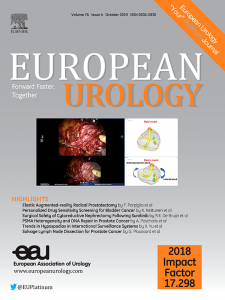欧洲泌尿外科协会尿石症的诊断和治疗指南
IF 25.3
1区 医学
Q1 UROLOGY & NEPHROLOGY
引用次数: 0
摘要
背景和目的欧洲泌尿外科协会尿石症指南为尿石疾病的诊断和治疗提供了循证建议。鉴于结石形成的复杂性和可变性,个性化的患者管理是强调的。方法该指南纳入了最新研究的证据,并侧重于风险评估、成像技术、药物管理和手术干预。一位研究馆员通过Dialog-Datastar在Cochrane图书馆、Medline和Embase数据库中检索尿石症的文献。推荐的强度也会被评估。主要发现和局限性诊断依赖于临床病史、生化评估和影像学的结合,超声作为一线方式,低剂量计算机断层扫描作为精确评估结石的金标准。结石组成和负担影响治疗决策的算法主要基于结石的大小、位置和组成。非甾体类抗炎药推荐用于一线疼痛治疗,阿片类药物保留作为次要选择。输尿管结石患者可考虑采用α-阻滞剂药物排出治疗。体外冲击波碎石术、输尿管镜检查和经皮肾镜取石术仍然是主要的干预方式,可根据结石特征和患者因素进行选择。多平面成像技术的进步改善了对结石负荷的评估,但需要进一步的研究来完善预测模型。建议对高危患者进行基因检测,以指导个性化治疗。结论和临床意义该指南为临床决策提供了一个框架,同时承认尿石症需要继续取得进展。本文章由计算机程序翻译,如有差异,请以英文原文为准。
European Association of Urology Guidelines on the Diagnosis and Treatment of Urolithiasis
Background and objective
The European Association of Urology urolithiasis guidelines provide evidence-based recommendations for the diagnosis and treatment of urinary stone disease. Given the complexity and variability of stone formation, individualised patient management is emphasised.
Methods
The guidelines incorporate evidence from the latest research and focus on risk assessment, imaging techniques, pharmacological management, and surgical interventions. A research librarian conducted literature searches for urolithiasis in the Cochrane Library, Medline, and Embase databases via Dialog-Datastar. The strength of recommendations is also rated.
Key findings and limitations
Diagnosis relies on a combination of clinical history, biochemical evaluation, and imaging, with ultrasound as the first-line modality and low-dose computed tomography as the gold standard for precise stone assessment. Stone composition and burden influence treatment decisions with algorithms primarily based on stone size, location, and composition. Nonsteroidal anti-inflammatory drugs are recommended for first-line pain management, with opioids reserved as a secondary option. Medical expulsive therapy with α-blockers may be considered for selected patients with ureteral stones. Extracorporeal shockwave lithotripsy, ureteroscopy, and percutaneous nephrolithotomy remain the primary intervention modalities, with selection based on stone characteristics and patient factors. Advances in multiplanar imaging have improved assessment of the stone burden, although further research is needed to refine predictive models. Genetic testing is recommended for high-risk patients to guide personalised treatment.
Conclusions and clinical implications
The guidelines provide a framework for clinical decision-making while acknowledging the need for continued advances in urolithiasis.
求助全文
通过发布文献求助,成功后即可免费获取论文全文。
去求助
来源期刊

European urology
医学-泌尿学与肾脏学
CiteScore
43.00
自引率
2.60%
发文量
1753
审稿时长
23 days
期刊介绍:
European Urology is a peer-reviewed journal that publishes original articles and reviews on a broad spectrum of urological issues. Covering topics such as oncology, impotence, infertility, pediatrics, lithiasis and endourology, the journal also highlights recent advances in techniques, instrumentation, surgery, and pediatric urology. This comprehensive approach provides readers with an in-depth guide to international developments in urology.
 求助内容:
求助内容: 应助结果提醒方式:
应助结果提醒方式:


